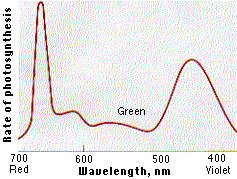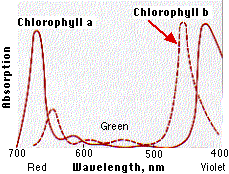
In 1881, the German plant physiologist T. W. Engelmann placed a filamentous green alga under the microscope and illuminated it with a tiny spectrum of visible light.
In the medium surrounding the strands were motile, aerobic bacteria.
After a few minutes, the bacteria had congregated around the portions of the filament illuminated by red and blue light.

Assuming that the bacteria were congregating in regions where oxygen was being evolved in photosynthesis, Engelmann concluded that red and blue light are the most effective colors for photosynthesis.
With modern instruments, a plot of the rate of photosynthesis as a function of wavelength of light produces a graph like this. More precise than Engelmann's but telling the same story.
An absorption spectrum is a spectrum of radiant energy whose intensity at each wavelength is a measure of the amount of energy at that wavelength that has passed through a selectively absorbing substance.
The absorption of radiation by a substance can be quantified with an instrument called a spectrophotometer. This is a device that The graph shows the absorption spectrum of a mixture of chlorophyll a and chlorophyll b in the range of visible light.
The graph shows the absorption spectrum of a mixture of chlorophyll a and chlorophyll b in the range of visible light. Note that both chlorophylls absorb light most strongly in the red and violet portions of the spectrum. Green light is poorly absorbed so when white light (which contains the entire visible spectrum) shines on leaves, green rays are transmitted and reflected giving leaves their green color.
The similarity of the action spectrum of photosynthesis and the absorption spectrum of chlorophyll tells us that chlorophylls are the most important pigments in the process. The spectra are not identical, though, because carotenoids, which absorb strongly in the blue, play a role as well.
The carotenoids help fill in the absorption gaps of chlorophyll so that a larger part of the sun's spectrum can be used. The energy absorbed by these "antenna pigments" is passed to chlorophyll a where it drives the light reactions of photosynthesis.| Link to the Light Reactions of Photosynthesis. |
Many substances absorb ultraviolet and/or infrared rays. Spectrophotometers are available for measuring absorption spectra in these regions as well.
| Welcome&Next Search |